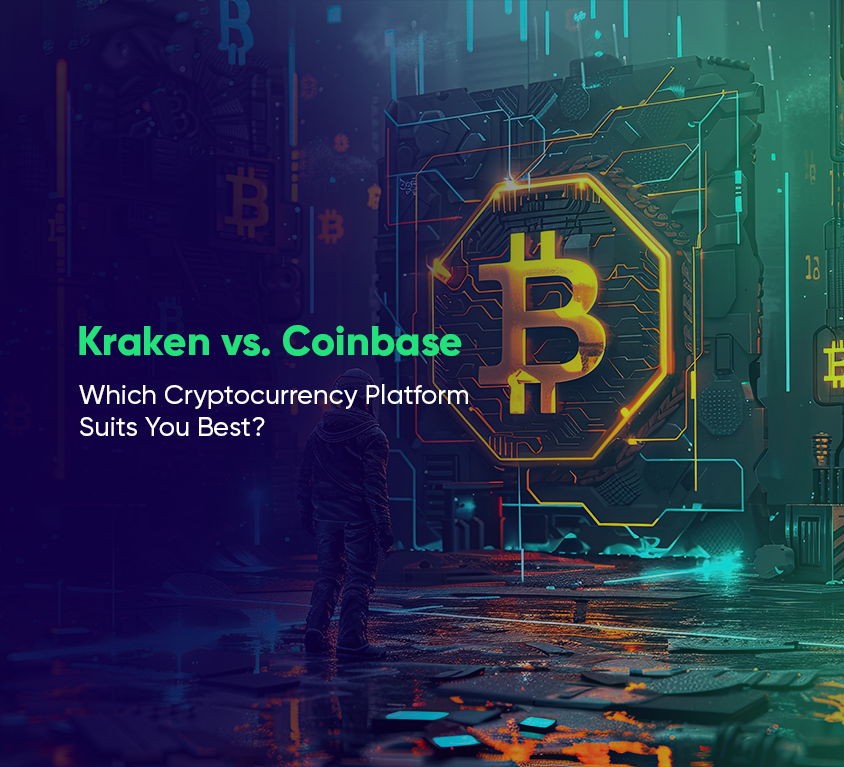
Introduction
Web3 & Blockchain Consultancy :
Kraken vs. Coinbase: Which Cryptocurrency Platform Suits You Best?
Kraken and Coinbase stand out as two prominent cryptocurrency exchanges globally. Both platforms support the purchase of various cryptocurrencies using traditional currencies like US dollars or Euros and are suited for both beginners and seasoned traders. Kraken is favored for its low transaction fees and high limits, making it appealing to both occasional and frequent traders. In contrast, US-based beginners often prefer Coinbase for its user-friendly digital wallet and versatile funding methods. Coinbase primarily serves US customers, and detailed insights about it can be found in our comprehensive review. This article examines the strengths and weaknesses of both Kraken and Coinbase, discussing their unique features, security measures, fee structures, user-friendliness, and more. Each platform provides useful tools such as mobile applications and round-the-clock customer support, but they cater to different types of investors. Kraken is beneficial for those trading in smaller volumes due to its consistent trading fees, while Coinbase simplifies transactions with options like PayPal and debit card payments, making it a favorite among American users.Key Takeaways
- Kraken offers lower fees and robust security, making it ideal for high-volume and international traders.
- Coinbase is user-friendly with a quick setup, suited for U.S. traders and beginners.
- Kraken provides broader international access, serving customers in 190 countries.
- Coinbase supports staking services for U.S. clients, which Kraken discontinued due to regulatory constraints.
- Both platforms provide 24/7 customer support and mobile app functionality, ensuring a reliable trading experience.
Kraken vs. Coinbase: Features
Both Kraken and Coinbase are leading cryptocurrency exchanges that serve both experienced investors and beginners. Kraken is known for its attractive features for international and US traders who prioritize lower fees and additional services over convenience. Coinbase, on the other hand, is designed to streamline the experience for US investors with its user-friendly digital tools. Here’s what both platforms offer:- Availability: Coinbase operates in over 100 countries, while Kraken is accessible in about 190 countries, though available services can vary by region. Notably, Kraken does not operate in New York, Washington, and Maine within the U.S.
- Customer Support: Both exchanges provide 24/7 global customer service through live chat. However, during periods of high trading activity, the availability of support might decrease, leading to longer wait times. Each platform also includes help center guides and FAQs.
- Margin Trading: Kraken allows crypto margin trading with up to five times leverage, which is standard in the industry. Coinbase introduced margin trading in early 2020 with up to three times leverage but discontinued it by November of the same year.
- Mobile Apps: Both Kraken and Coinbase offer highly rated mobile apps that mirror the capabilities of their web versions. However, Kraken’s app is not available in four countries and three territories.
Kraken vs. Coinbase: Currencies
Both platforms handle several major fiat currencies including USD, EUR, CAD, AUD, GBP, CHF, and JPY. Coinbase offers trading in over 240 different cryptocurrencies, while Kraken provides access to more than 200. Each exchange carries a unique assortment of digital currencies, so users can explore both platforms to find specific cryptocurrencies they are interested in. For example, Kraken lists currencies like Flow (FLOW) and Icon (ICX) for trading. On the other hand, Coinbase allows trading in cryptocurrencies such as Filecoin (FIL) and Yearn Finance (YFI), but does not support Tron (TRX) or Siacoin (SC). Among the most widely traded cryptocurrencies that both Kraken and Coinbase support are:- Cardano (ADA)
- Bitcoin Cash (BCH)
- Chainlink (LINK)
- Ethereum (ETH)
- Litecoin (LTC)
Kraken vs. Coinbase: Security
Security is a top priority when choosing a cryptocurrency exchange. Both Kraken and Coinbase are known for their strong security measures and regulatory compliance, with no major security breaches reported. Kraken ensures the safety of the majority of its assets with air-gapped cold storage that is heavily guarded, along with thorough monitoring systems and several verification stages during the registration process. Coinbase secures 98% of customer deposits in cold storage spread across various locations. Additionally, the Federal Deposit Insurance Corporation (FDIC) protects up to $250,000 of an individual’s USD holdings, which is beneficial for traders in the U.S. Both Kraken and Coinbase employ several layers of security to protect user information and funds:- Security Keys: These physical devices can be plugged into a computer to authenticate logins and generate a temporary passcode. Users can create multiple keys for backup and store them safely.
- Pretty Good Privacy (PGP): Both platforms offer instructions on setting up PGP encryption for emails, ensuring that any communication regarding your cryptocurrency transactions remains confidential and secure.
- Two-factor Authentication (2FA): Both exchanges enable 2FA for withdrawals and transfers to enhance security. Coinbase automatically uses 2FA via SMS for logins.
- Authenticator Apps: As an alternative to SMS or email, both Kraken and Coinbase support 2FA through authenticator apps. These apps, including Google Authenticator, provide an added layer of security by generating time-sensitive codes.
Kraken vs. Coinbase: Fee Structures
There’s a notable difference in how Kraken and Coinbase structure their transaction fees. Kraken is known for having some of the lowest maker-taker fees in the industry, whereas Coinbase’s fees are comparatively higher. Kraken’s fees are determined by your trading volume over the last 30 days, with the following fee tiers:- For transactions from $0 to $10,000: 0.25% for makers, 0.40% for takers
- For $10,001 to $50,000: 0.20% for makers, 0.35% for takers
- For $50,001 to $100,000: 0.14% for makers, 0.24% for takers
- For $100,001 to $250,000: 0.12% for makers, 0.22% for takers
- For $500,001 to $1,000,000: 0.08% for makers, 0.18% for takers
- For $1,000,001 to $2,500,000: 0.06% for makers, 0.16% for takers
- For $2,500,001 to $5,000,000: 0.04% for makers, 0.14% for takers
- For over $5,000,001 to $10,000,000: 0.02% for makers, 0.12% for takers
- For transactions over $10,000,000: 0% for makers, 0.10% for takers